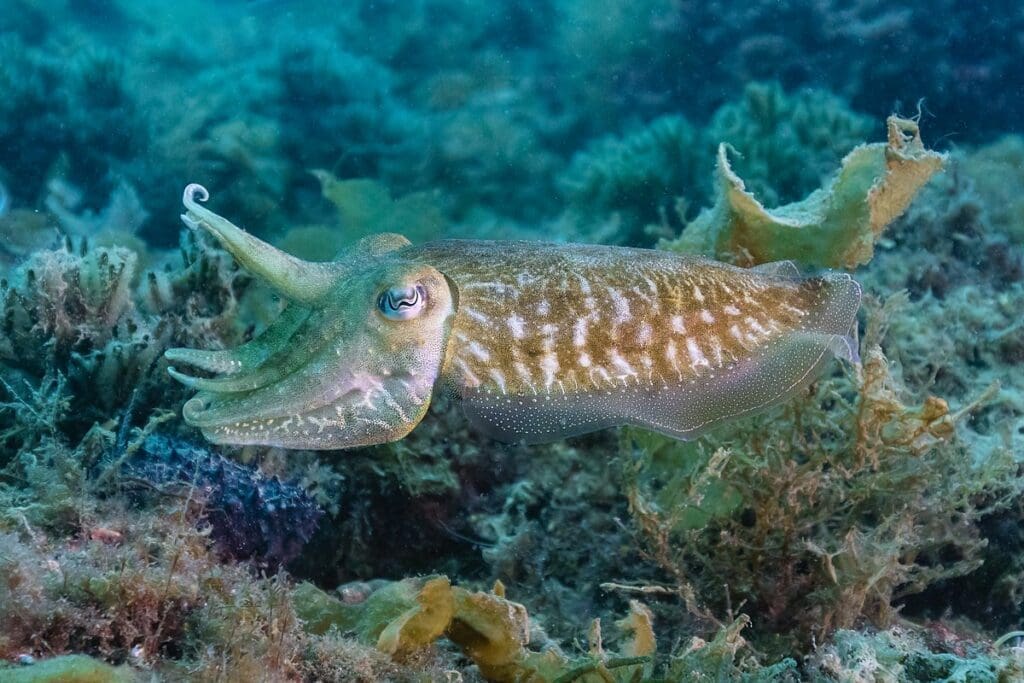
Sepia officinalis
Latin name: Sepia officinalis
Short name: Sep
Common name: Cuttlefish Ink | Sepia | Inky Juice of Cuttlefish | Marine Ink | Cephalopod Ink
Primary miasm: Sycotic Secondary miasm(s): Psoric, Syphilitic
Kingdom: Animals
Family: Cephalopoda
- Symptomatology
- Remedy Information
- Differentiation & Application
Prepared from the inky secretion of the cuttlefish (Sepia officinalis), a cephalopod mollusc native to the Atlantic Ocean and Mediterranean Sea. The ink contains melanin, mucus, and amino acids, and was historically used in writing, painting, and dyeing.
Used in artistic ink (sepia tone), traditional Chinese and Mediterranean medicine for its astringent and detoxifying properties, and as a symbol of melancholy in literature and art.
First proved by Hahnemann, later confirmed and enriched by Hering, Boericke, and Clarke.
- Female reproductive system: uterus, ovaries, vagina
- Pelvis: venous stasis, prolapse, dragging sensations
- Liver and portal system: sluggishness, bloating
- Circulatory system: varicosities, hormonal congestion
- Mind and emotions: indifference, irritability, hormonal mood shifts
- Rectum and anus: constipation, haemorrhoids, prolapse
- Skin and pigmentation: chloasma, eruptions, sweat disorders
- Left side, especially pelvic organs
- Vigorous exercise (especially dancing, walking fast) [Kent]
- Pressure, including firm massage or binding clothing
- Warmth generally, but not always for flushes
- Loosening clothing, especially around the waist
- Crossing legs, particularly to relieve pelvic heaviness
- Open air, though chilly types may prefer warmth
- Occupying the mind or emotional distraction
- Before, during, or after menstruation (notably premenstrual)
- Pregnancy, menopause, or any hormonal transition
- Emotional neglect, repression, or suppressed grief
- Inactivity, prolonged standing, or sitting
- Touch, especially light touch
- Early morning and evening
- Coitus, especially in women with suppressed libido
- Cold air, though some symptoms paradoxically improve from cold bathing
- Pulsatilla – Also mild and weepy, but Puls. desires consolation and is emotionally open; Sep. is indifferent and averse to sympathy
- Lachesis – Also left-sided, hot, hormonal, but Lach. is loquacious, passionate, and explosive; Sep. is withdrawn, irritable, and cold
- Sulphur – Also burning, tired, and untidy; Sulph. lacks Sepia’s strong pelvic affinity and emotional disconnection
- Nux vomica – Similar irritability, fatigue, and digestive issues; Nux is tense, overdriven; Sep. is flat, indifferent, emotionally exhausted
- Ignatia – Also a remedy for grief and suppression; Ign. is sensitive, dramatic, and sighing; Sep. is detached, dull, and weary
- Complementary: Nat-m., Calc., Lyc.
- Antidotes: Puls., Lach., Nux-v.
- Inimical: Ferr.
- Follows well: Puls., Sulph., Nux-v.
- Precedes well: Nat-m., Sil., Sulph.
Sepia is the archetype of emotional depletion, especially in overburdened women. She is the worn-out mother, the menopausal wife, the postpartum patient whose emotions have dulled from duty. She withdraws to survive, pushing love away, not because she doesn’t care—but because she can no longer give. The pelvis is heavy, the spirit is heavier. Sepia’s healing lies in reconnection, vital motion, and releasing suppressed sadness.
- Top remedy for uterine prolapse, hormonal depression, and menopausal flushes
- Excellent in postpartum fatigue, premenstrual syndrome, and chronic vaginitis
- Mind-body alignment: mental indifference often reflects pelvic or hepatic stagnation
- Use in chloasma, constipation with bearing-down, and irregular menses
- Acute: 30C–200C; Chronic: 200C–1M
- Avoid over-repetition in sensitive constitutions; spacing is key
Mind
- Indifference, loved ones to
- Irritability, before menses
- Aversion to consolation
- Sadness, weeping, alone amel.
- Desire to be alone
Head
- Headache, menses before
- Pain, left side
- Hair, falling
Stomach
- Nausea, morning
- Craves, vinegar
- Aversion, meat, fat
- Empty sensation, not better from eating
Female
- Prolapse, uterus
- Leucorrhoea, egg-white
- Menses, irregular, scanty
- Sexual desire, diminished
- Pain, coition after
Back
- Pain, lumbosacral region
- Weakness, standing agg.
- Coccyx, soreness
Skin
- Chloasma
- Eruptions, premenstrual
- Itching, wool agg.
Generalities
- Better, exertion, dancing
- Worse, before menses
- Aversion to touch
- Left-sided complaints
Samuel Hahnemann – Materia Medica Pura: First proving, outlined general and pelvic indications
James Tyler Kent – Lectures on Homoeopathic Materia Medica: Offered rich analysis of Sepia’s emotional and physical states, particularly in women
C. Hering – Guiding Symptoms of Our Materia Medica: Deep clinical insights into uterus, rectum, and liver function
William Boericke – Pocket Manual of Homoeopathic Materia Medica: Practical applications in gynaecology, dermatology, and endocrinology
John Henry Clarke – Dictionary of Practical Materia Medica: Expanded modality notes, including exercise amelioration and emotional aetiology
